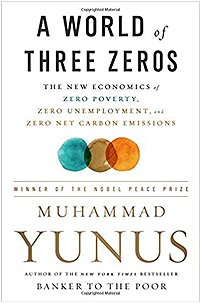Financial inclusion and the regulation of microfinance
By Muhammad Yunus
Financial crises illustrate a fundamental flaw in the way the current financial system is organized. The financial institutions and banking systems of advanced economies focused on big banks and big customers. This system embodies a kind of financial apartheid; two thirds of the world's populations are excluded. Unless we bring these people into the financial system, crises will keep recurring.
Grameen finances everyone. It has demonstrated that even beggars can be financed. We have around 100,000 beggars in the programme: they borrow small amounts of money to buy goods that they can offer for sale when begging from door to door. Some have left begging this way and started their own businesses.
Grameen Bank has 8.3 million borrowers, of whom 97% are women. The bank borrows no money from the outside, it is entirely self-financed. It takes deposits from people and gives small loans to poor people. So far it has given more than $10 billion in microloans, with a recovery rate of 97%.
The issue for this audience is how to make this story happen in Africa. Women in Africa are at the forefront of the fight for equality of financial access. Microfinance already exists in Africa. But, in my view, it should be done by specialized institutions, not commercial banks or NGOs. The issue is how to make such microfinance institutions part of the mainstream banking system. In Bangladesh, a special banking law was created for Grameen Bank. I think we should aim for a banking law for banks for the poor.
Grameen is the reverse image of existing banking systems. Banks finance rich people; Grameen finances the poor. Banks finance men; we finance women. Banks lend in cities; we lend in villages. Banks lend money against collateral; we ask for no collateral. Banks depend on lawyers; Grameen has no lawyers. In fact, we knew nothing about banking when we set out to establish Grameen. But, in a way, this did not matter - our goal was to create self-employment, not profit.
Today it is easier to establish such a bank with the new technology that is available. Young people should be job-givers, not job-seekers. They should think of how to create jobs, not how to make themselves employable. Developing an open financial system and making available the benefits of new technologies will help us reach the UN's Millennium Development Goals.
Recently there has been some controversy about microfinance in Mexico, and lately also in India. The controversy stems from the fact that the original goal of microfinance from the 1970s was abandoned when microfinance institutions turned to profit-making rather than supporting self-employment and job creation. Microfinance led some people to strive for profit rather than social goals.
This is the reason why a special legal framework is needed to support microfinance. Microfinance cannot operate in a vacuum; it has to be regulated. But the regulatory authority needs to be separate from the central bank because regulating microfinance is different from regulating conventional banks. Microfinance is about "social business", not profit-making business. The social dimension concerns the selfless part of human beings, i.e., solving problems such as creating jobs for others, not the selfish part, which is concerned with profit-making. Traditional banking regulation deals with banking as a profit-making business. It is not equipped to regulate microfinance.


